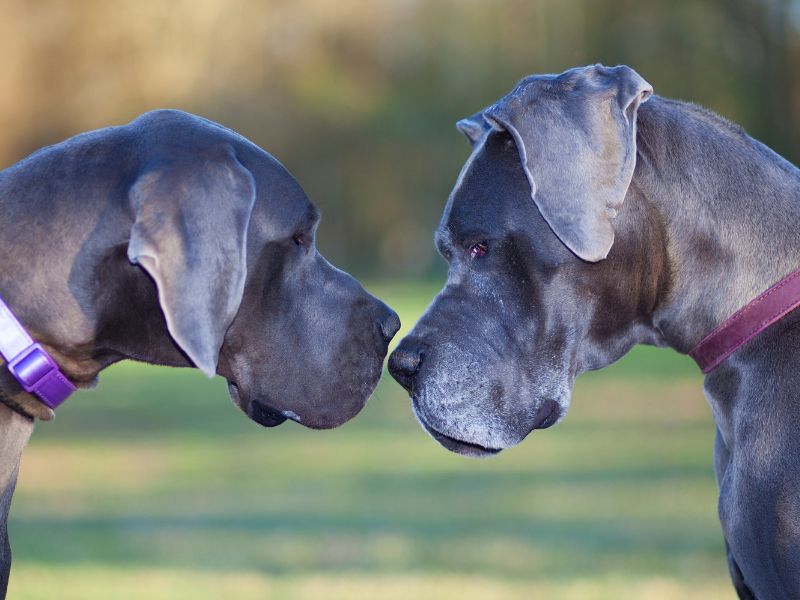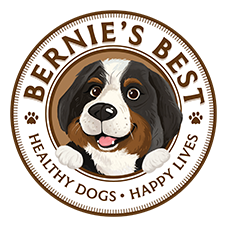Strong Joint Health for Large Breed Dogs

Due to their size and body weight, large breed dogs often place more stress on their joints than their smaller counterparts. This can make them more prone to developing issues like arthritis, hip dysplasia, and other orthopedic conditions. It’s imperative to keep an eye on their joint health, engage in preventive measures, and seek timely interventions if problems arise.
Symptoms of Joint Pain in Dogs
Knowing what to look for can make all the difference. Some common signs of joint pain or joint stress in giant breed dogs include:
- Limping: Even if it’s occasional or only after vigorous play. Limping may mean there’s an issue with joint function.
- Difficulty Rising: Struggling to stand after lying down may mean your big breed dog has joint problems. While senior dogs typically show this due to their age, it’s not always a given that age causes joint stress. Giant breed dogs will likely have a more challenging time if they also deal with joint disease.
- Stiffness: Especially noticeable after long rests. Degenerative joint disease can show itself initially if your dog is stiff after a long rest period. This is particularly more noticeable in bigger breeds.
- Swelling: In the joint areas. You definitely want to look into how to best support joint health.
- Pain: Manifested by signs of discomfort when the area is touched.
Hip Dysplasia, Arthritis, and Other Orthopedic Problems in Large Breed Dogs
Due to their rapid growth, large breed dogs can sometimes develop hip dysplasia. This is a condition where the hip joint doesn’t develop correctly. This condition, if left untreated, can lead to arthritis. Regular vet check-ups and early interventions, like weight management, quality joint supplements, and even physical therapy, may help manage these issues.
How to Recognize Osteoarthritis in Your Dog
Osteoarthritis, a common ailment in older dogs, especially larger breeds, is characterized by the wearing away of the cartilage that cushions the joints. Signs to watch out for include:
- Decreased Activity: Less enthusiasm for play or walks.
- Reluctance: To climb stairs or jump onto elevated surfaces.
- Visible Joint Swelling: Especially in the hips or knees.
- Audible Sounds: A grinding or clicking noise from their joints.
Supporting Joint Health for Large Breed Dogs
Beginning with Baby Barks: The Role of Early Nutrition For Large And Giant Breeds
Starting your young pup with the right nutrition plays a crucial role in their long-term joint health. Your dog’s gut has a lot of involvement when it comes to how to preserve joint function for their future! The gut is not just a food processing unit; it’s an epicenter of immune regulation, nutrient absorption, and inflammation control.
When your dog has a healthy gut, they absorb nutrients better. Proper absorption ensures that their body receives all the good stuff, from proteins to micronutrients, which aids in building strong bones and joints. Moreover, a healthy gut can prevent unwanted inflammation, which can aggravate joints and lead to more significant issues later on.
But the gut doesn’t act alone regarding joint health in dogs. There’s also microflora–beneficial bacteria that help break down food, produce essential vitamins, and keep harmful bacteria in check. When the balance of good to bad bacteria is disturbed, the gut lining can be damaged, leading to what’s called a ‘leaky gut.’ This not-so-fun condition allows toxins and bacteria to enter the bloodstream, causing systemic inflammation. This is the nemesis of joints everywhere inside your dog’s body, and why dogs are often prescribed Non-Steroidal Anti-inflammatory medications to help treat joint pain.
Exercise Tips for Protecting Large Breed Dog Joints
In addition to good food, good diets and great supplementation, when it comes to a dog’s joint health, exercise matters! Regular exercise is vital for all dogs, but the activity typetype of activity is crucial for larger breeds because you really need to protect your dog’s joints. Some of our favorite tips include noting the following:
- Low-Impact Activities: Swimming and walking are excellent as they strengthen muscles without stressing the joints. Muscle mass is important to take into consideration with exercising adult dogs, as it contributes to pressure on their frames.
- Avoid Repetitive High-Impact Activities: Jumping or hard fetch play isare tough on a large dog, even though it may seem like they love it. They probably do, but their affected joints don’t. This is essential to remember in puppies as their growth plate is still developing.
- Regular, Short Sessions: This is better than long, infrequent ones as it keeps your dog’s joints moving but not for prolonged amounts of time. A few minutes here and there throughoutthrough the day is better than larger chunks but not as frequently.
- Weight Management: Healthy joints rely on you keeping your dog at a healthy weight. In large dogs, that healthy weight may be harder to obtain than in smaller dogs, but overweight dogs have more strain on their joints, and this can affect their overall health too.
Does My Dog Need Joint Supplements?

Is there anything better than your best furry friend joyfully coming at you with all the love they have to offer? The problem is that the risk of joint stress comes with their leaps and bounds, particularly in large breeds. Fortunately, new science has given us a leg up (or four) on this issue.
No, we’re not knocking old tricks, but it’s important to know that new tricks can sometimes teach old dogs a thing or two. Sometimes, it really does pay to switch up the treat bag. While a balanced diet and exercise are essential, joint supplements can play a preventive or therapeutic role in helping your large breed dog have the best joint health it can. They offer essential nutrients and compounds that promote joint health, reduce inflammation, and enhance mobility–all key components of a healthy, happy life.
How To Choose a Dog Joint Supplement
- Ingredients Matter: Look for supplements with natural, proven ingredients that promote joint health and reduce inflammation. More, consider the science. We continue to find new ways to help our dogs live their best lives, and research is finding benefits from natural ingredients that do incredible things.
- Quality Over Quantity: Opt for reputable brands with transparent sourcing practices.
- Formulation: Choose what’s convenient and palatable for your dog. Dogs love treats, and joint supplements in treat forms are usually super easy to give regularly.
- Consult Your Vet: It’s never a bad idea to talk to your vet about the science of supplementation.
New Kids on the Block: Ingredients That Really Make a Difference
When it comes to joint inflammation medicines, chondroitin and glucosamine are almost always at the top of every ‘go-to’ list. They’ve definitely had their time in the spotlight (and hey, they’re not totally off the charts). But, if honest, they’ve somewhat become the ‘boy bands’ of the joint health world—well-known and popular but not necessarily the latest and greatest when it comes to efficacy and helping with joint mobility. Today, there’s a whole generation of chart-topper ingredients are hitting the high notes when it comes to promoting joint health and possibly helping prevent joint damage in large dogs. When we decided to create supplements for our own large dogs, we wanted the ones that are research-backed, have clinical efficacy rates that show them to be impactful, and weren’t just ‘the old standard’ in joint health care. These are what we found, and what we use in our joint health supplements for dogs.
- Blueberry Powder & Green Tea Extract (Decaf.): Rich in antioxidants, they combat free radicals that can cause cellular damage and inflammation.
- Turmeric & Boswellia: This is kind of like a dynamic duo of nature, known for their powerful anti-inflammatory properties.
- Yucca Schidigera & Black Pepper Extract: Not only do they enhance digestion, but they also help in reducing inflammation.
- Astaxanthin: A super antioxidant, great for reducing oxidative stress.
- Undenatured Type-II Collagen: Essential for cartilage health and preventing autoimmune joint deterioration.
- Flaxseed Oil & Anchovy Oil: Omega-3s from fish oil are AMAZING. These fats reduce inflammation and support joint fluidity.
- VermarisⓇ EPA + DHA, Algal Oil: More Omega-3 sources, because, let’s face it, joints love them!
- Green Lipped Mussels: A fancy mollusk that’s packed with essential fatty acids and minerals. Green lipped mussels are up and coming for human joint health as well!
- Kelp Powder, Vitamin C, Boron, & Vitamin K2: Boost bone density and support collagen synthesis.
Now, some popular brands might be holding onto glucosamine and chondroitin like a dog with a favorite chew toy. But the truth is that the canine nutrition world has grown leaps and bounds and offers a smorgasbord of natural ingredients that may work wonders for joint health.
Choosing the Right Treat for Your Tail-Wagger
We’re not saying you should necessarily throw out any of the info behind your favorite glucosamine and chondroitin joint supplement. However, we ARE saying that when you’re looking for the best joint supplement for dogs and overall joint health, it’s worth sniffing around the newer, holistic options steeped in science and not just ‘popular.’ Apart from being beneficial for potentially helping with joint disease, these natural ingredients often provide a host of other health benefits for your dog, including skin health, digestive health and pain relief.
Care of your large breed dog’s joints starts early and really requires a holistic approach. Focus on gut health, offer them a diverse range of natural ingredients, and remember that while old favorites have their place, it’s always good to keep an ear to the ground for the latest in canine health and nutrition. That’s what we’re all about at Bernie’s Best because it’s what we want for our own dogs- the very best!





